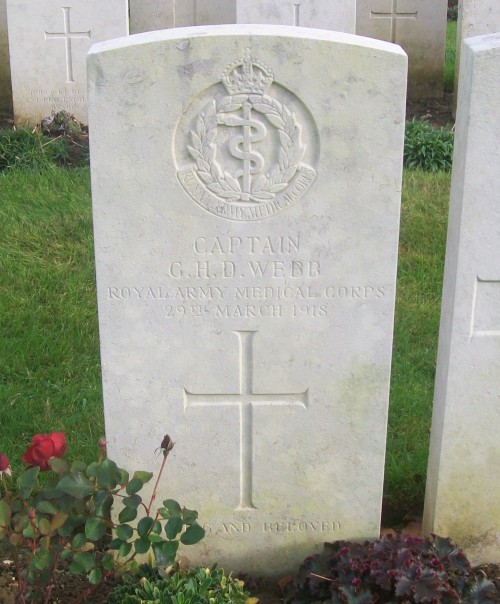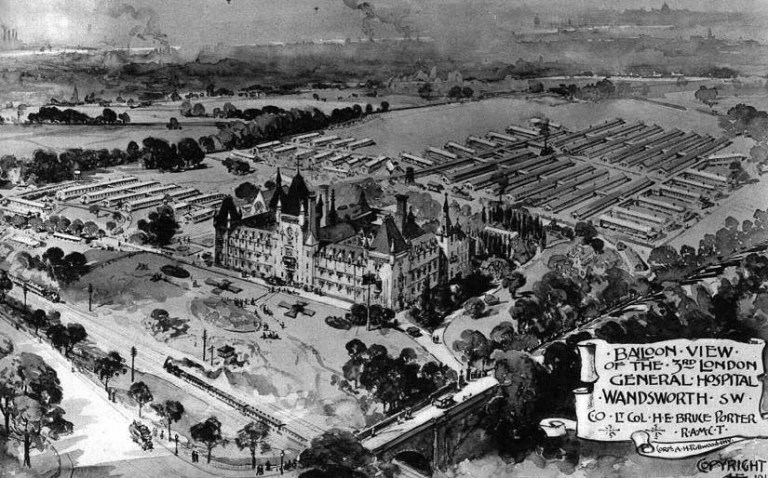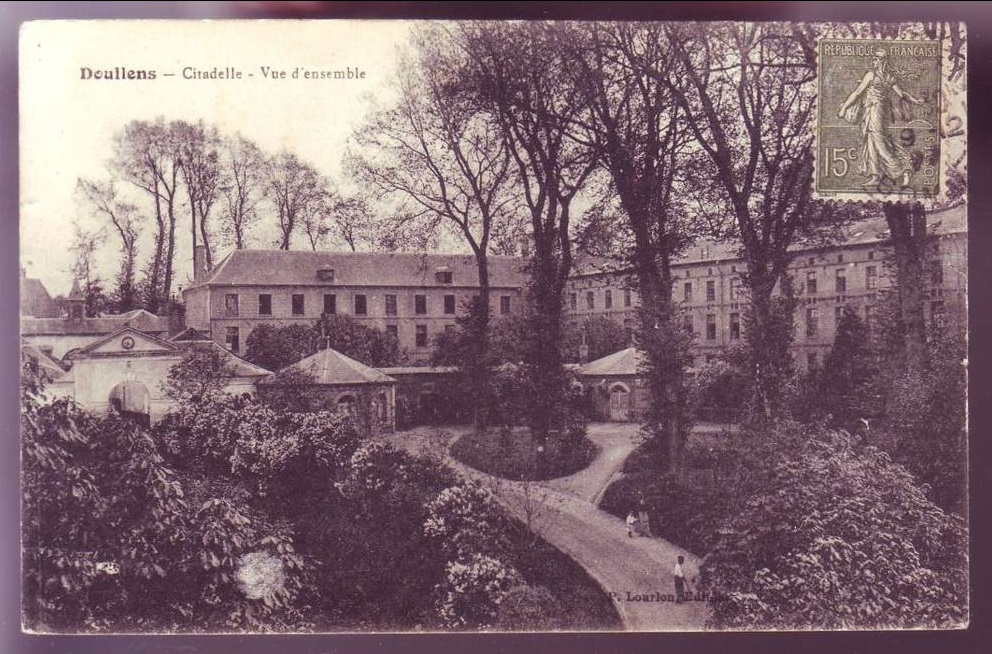 Regiment: Royal Army Medical Corps, attached to 5th Dragoon Guards
Regiment: Royal Army Medical Corps, attached to 5th Dragoon Guards
Date & place of birth: 13 October 1881 at St Johns Wood, London
Date & place of death: 29 March 1918, aged 36, at Doullens, France
George Webb had qualified as a doctor shortly before the outbreak of the First World War He died of wounds less than two months after being sent to France.
Family background
George Harvey Duder Webb was born on 13 October 1881 at 111 Clifton Hill, St Johns Wood in north-west London, the second son of John Cother Webb (1855–1927) and his wife Jane née Duder (1855–1923).
At the age of 14, John Cother Webb became a student of Thomas Landseer (brother of Sir Edwin Landseer), an artist who was best known for his engravings and etchings. John had his first exhibition of engravings at the Royal Academy at the age of 21 in 1875. He was later responsible for the promotion of the mezzotint as a desirable item for collecting.
John married Jane Duder, the daughter of a wealthy farmer, in Totnes, Devon in October 1878. The couple settled at 111 Clifton Hill, St Johns Wood, where they remained for the rest of their lives. Their first child, Maurice, was born in May 1880 followed by George 3½ years later. (George took his second Christian name from his maternal grandmother.) The couple had two further children, John, born in March 1883 and Frances, born in June 1892.
At the 1901 census, George was living with his parents and two brothers at 111 Clifton Hill. On the census, Maurice is described as a student at Oxford University, while George, aged 19, is described as a “stockbroker’s clerk”.
Ten years later, in March 1911 George was still resident with his parents, but was now described as a medical student. On the census, a guest at the family home was 28-year old Eva McPherson, from St. John’s, Newfoundland.
On 12 June 1912, at St Marylebone Parish Church, George and Eva were married. On the marriage certificate, George’s occupation is given as “gentleman” and his address as 16 Oldbury Place, a few hundred yards from the church.
Eva’s parents had both died in 1908, in their mid-50s: her father, Campbell Macpherson (1851–1908), had been an accountant in St. John’s. Her mother Emma Duder (1852–1908) appears to have been a distant relative of George’s mother, Jane. Emma’s father, Henry John Duder (1820–1888), had been born in St Marychurch, in Devon, close to Jane’s birthplace at Totnes, but in his teens had migrated to Canada with his parents, where he became a successful businessman.
George and Eva’s first two children, John Campbell and Jane Emma were born at 32 Park Drive, Hampstead (also shown as Golders Green) on 4 May 1913 and 9 June 1915 respectively.
In the 1915 Medical Directory, George’s address was given as “Moreton”, Park Drive, North End, Hampstead, N.W. London.
Their third child, named George Harvey Duder Webb after his father, was born in a Southampton nursing home on 4 April 1917.
In November 1917, when George was initiated into Freemasonry, his address is recorded as “Bursledon”. At the time of George’s death, his widow’s address was The Lawn, Old Bursledon, although George’s address remained at “Moreton”.
Medical career
From 1909, George studied at University College, London, from where he graduated in 1914 with the M.R.C.S. (Membership of the Royal College of Surgeons) and L.R.C.P. (Licentiate of the Royal College of Physicians). Following the declaration of war in August 1914, he joined the 3rd London General Hospital, where he remained until sent to France in 1918.
 The 3rd London General Hospital was founded in August 1914 in the premises of the Royal Victoria Patriotic School in Trinity Road, Wandsworth. At first, the hospital had only 200 beds, but was quickly expanded by the construction of 10 hutted wards in the grounds. As the war progressed, and casualty numbers grew, further wards were constructed, so that by 1918 the hospital had accommodation for 2,000 patients.
The 3rd London General Hospital was founded in August 1914 in the premises of the Royal Victoria Patriotic School in Trinity Road, Wandsworth. At first, the hospital had only 200 beds, but was quickly expanded by the construction of 10 hutted wards in the grounds. As the war progressed, and casualty numbers grew, further wards were constructed, so that by 1918 the hospital had accommodation for 2,000 patients.
Masonic career
Om 27 November 1917, aged 36, George Webb was initiated into Twelve Brothers Lodge No 785 at Freemasons’ Hall, Albion Place, Southampton. His military service prevented him from making further Masonic progress.
Military service
On 20 August 1914, George was commissioned as a Lieutenant in the Royal Army Medical Corps based at the 3rd London General Hospital. On 3 April 1915, he was promoted to Captain.
On 1 February 1918, George was sent to France where he spent his first few days at the Le Havre base before joining the 9th Cavalry Field Ambulance on 12 February at Courcelles, 7km east of Peronne. Two days later, he was attached as Medical Officer to the 5th (Princess Charlotte of Wales’s) Dragoon Guards, part of the 1st Cavalry Division, at nearby Buire.
As the Battalion Medical Officer, George Webb had an arduous task, combining the roles of G.P., casualty officer in battle, and public health officer responsible for the general health of his unit. In action, his role was to sort casualties between those who had no chance, those who required early life saving intervention before they could be evacuated to a Casualty Clearing Station, and those who needed less urgent treatment.
After nearly a month with little activity, the first major incident came on 9/10 March when the Guards raided the enemy lines, coming under heavy machine gun fire, resulting in the death of one officer (Lieut. George Ralph Miles) and serious injury to another (Lieut. Edmund Harry Tattersall, who had a leg amputated), with three Other Ranks being killed and several injured. (Lieutenants Miles and Tattersall received the Military Cross and the Distinguished Service Order respectively for their actions during the raid.)
By 21 March, when the German army launched their Spring Offensive, codenamed “Operation Michael”, the 5th Dragoon Guards had moved 10km south to Montécourt. Early that morning, six German divisions easily overcame the solitary Allied division holding the line between the Rivers Scarpe and Oise.
In the afternoon, the Guards were ordered to move up to Vendelles, 11km north-east, to reinforce the line, but soon came under a heavy bombardment and were forced to retire. Over the next week the Guards, along with most of the Allies, retreated at a rate of about 15km a day, frequently fighting rearguard actions until they reached Beaumont-Hamel, north of Albert, on 27 March where they held their ground until they were relieved on 3 April.
Death and commemoration
George Webb was injured at Hamel on 28 March and was taken to the 3rd Canadian Stationary Hospital based in the citadel at Doullens, where he died of his wounds the following day.
 Neither the battalion war diary nor the regimental history give any detail of how George was injured. The events of 28 March are recorded thus in the war diary:
Neither the battalion war diary nor the regimental history give any detail of how George was injured. The events of 28 March are recorded thus in the war diary:
10:30 am. With a view to finding out how strongly the enemy were holding the trenches in front of Hamel, 2/Lt. D.W. Whitlock took out a patrol of 8 O.R’s and 1 Hotchkiss Rifle. The Hotchkiss Rifle was successfully brought into action against a hostile working party when the patrol had advanced 200 yds. Patrol was then fired upon by 4 hostile M.G’s and returned to our trenches suffering no casualties.
11:00 am. Intense shelling of Hamel and front line throughout the day.
3:00 pm. Regiment withdrew from the trenches and went into support behind Queen’s Bays.
Fairly quiet night.
George was buried in Doullens Communal Cemetery Extension No. 1. His grave bears the inscription: “Loving and Beloved”.
He is commemorated on the war memorials at St Leonard’s Church, Bursledon and at St Jude-on-the-Hill Church in Hampstead. He is also commemorated on the Royal Army Medical Corps Transport Memorial in St. Peter’s Church in Wolverhampton, although his connection with that particular unit is unknown.
[The 3rd Canadian Stationary Hospital at Doullens was attacked by enemy aircraft on 29/30 May 1918, resulting in the deaths of 11 patients and 21 doctors and nursing staff. Captain Thomas Fleck Graham of the Canadian Army Medical Corps, subsequently died from the effects of exhaustion resulting from his efforts in saving patients from the effects of the bombing. He was a member of South Saxon Lodge No. 311, based at Lewes in Sussex.]
Other family members & subsequent family history
After George’s death, his widow, Eva, changed the family name to Harvey–Webb. On 31 December 1919, she re-married to Dr. James Young, D.S.O., F.R.C.S.E., F.R.C.O.G. (1883–1963). James Young had served with the Royal Army Medical Corps throughout the war, reaching the rank of Lieutenant-Colonel, and saw service in Gallipoli, Palestine, France, and Egypt. He later became an eminent gynaecologist.
Eva and John had a daughter, Margaret Eva, born in Edinburgh in 1921. After the death of her second husband, Eva returned to Newfoundland, where she died in 1966.
George and Eva’s son, George served with the Royal Artillery during the Second World War and was subsequently with the Royal Army Educational Corps., with the rank of Captain. He died in December 1994 in London. His brother, John died in Newfoundland in 1983, and his sister died in Inverness in 1996.
Eva had two brothers. Harold Macpherson (1884–1963) helped protect the Newfoundland dog from extinction. Cluny Macpherson (1879–1966) was a physician and the inventor of an early gas mask, the British Smoke Hood.
Sources
Ancestry.co.uk
1881 England Census
1891 England Census
1901 England Census
1911 England Census
Army Registers of Soldiers’ Effects, 1901–1929
British Army WWI Medal Rolls Index Cards, 1914̅–1920
London, England, Church of England Marriages and Banns, 1754-1921
National Probate Calendar (Index of Wills and Administrations), 1858–1966
Soldiers Died in the Great War, 1914–1919
United Grand Lodge of England Freemason Membership Records, 1751–1921
UK & Ireland, Medical Directories, 1845-1942
UK, Medical and Dental Students Registers, 1882-1937
UK, Memorial Books WWI and WWII, 1914-1945
University of London Student Records, 1836-1945
The British Medical Journal:
11 September 1915. Naval and Military Appointments
13 April 1918. Casualties in the Medical Services.
CWGC Casualty Details: Captain Webb, G.H.D.
Find a Grave: Capt. G H D Webb
Great War Forum: Captain George Harvey Duder Webb. RAMC
Hampshire War Memorials. Bursledon. Webb, George Harvey Duder.
Heritage, Newfoundland & Labrador: The Newfoundland Dog
The Indian Medical Gazette. August 1918. Service notes
The Lancet: 25 May 1963. Obituary – James Young, D.S.O., M.D. Edin., F.R.C.S.E., F.R.C.O.G.
J.C. Leissring Fine Arts: John Cother Webb
Lost Hospitals of London: Third London General Hospital
London Gazette:
20 October 1914 Issue: 28945 Page: 8412
31 August 1915 Supplement: 29281 Page: 8713
The London WW1 Memorial: George Henry Duder Webb
Masonic Roll of Honour: Captain George Harvey Duder Webb
Morning Post: 28 July 1909. Royal College of Physicians & Surgeons
Pomeroy, Ralph Legge: History of the Fifth (Princess Charlotte of Wales’) Dragoon Guards, Vol. 1 2006. pp. 120–122
The National Archives:
WO 95/1105/2. 9 Cavalry Field Ambulance war diary
WO 95/1109/2. 5 Dragoon Guards war diary
WO 374/72688. Captain George Harvey Duder Webb. Royal Army Medical Corps.
Riggs, Bert: The Legacies of the Duder family
Roll of Honour. Bursledon War Memorial
St Jude-on-the-Hill Parish Church: Roll of Honour 1914-1919
Wikipedia: Cluny Macpherson
Wolverhampton War Memorials. St Peters Church, Royal Army Medical Corps Transport Memorial.
Photograph credits
Gravestone: London War Memorials
3rd London General Hospital: Black Cab London
No. 3 Canadian Stationary Hospital at Doullens: Throughtheselines.com.au